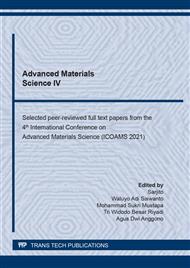[1]
A.V. Bridgwater, D. Meier, D. Radlein, An overview of fast pyrolysis of biomass. Org. Geochem. 30, 12 (1999) 1479-93.
DOI: 10.1016/s0146-6380(99)00120-5
Google Scholar
[2]
G. Kabir and B.H. Hameed, Recent progress on catalytic pyrolysis of lignocellulosic biomass to high-grade bio-oil and bio-chemicals. Renew. Sust. En. Rev. 70 (2017) 945–967.
DOI: 10.1016/j.rser.2016.12.001
Google Scholar
[3]
R.B. Cahyono, A.N. Rozhan, N. Yasuda, T. Nomura, S. Hosokai, Y. Kashiwaya, T. Akiyama, Catalytic coal-tar decomposition to enhance reactivity of low-grade iron ore. Fuel Proc. Tech., 13 (2013) 84–89.
DOI: 10.1016/j.fuproc.2013.03.012
Google Scholar
[4]
H. Zhao, Y. Li, Q. Song, J. Lv, Y. Shu, X. Liang, X. Shu, Effects of Iron Ores on the Pyrolysis Characteristics of a Low-Rank Bituminous Coal, En. Fuels, 30 (2016) 3831−3839.
DOI: 10.1021/acs.energyfuels.6b00061
Google Scholar
[5]
R. Wei, S. Feng, H. Long, J. Li, Z. Yuan, D. Chang, C. Xu, Coupled biomass (lignin) gasification and iron ore reduction: A novel approach for biomass conversion and application, Energy, 140 (2017) 406-414.
DOI: 10.1016/j.energy.2017.08.080
Google Scholar
[6]
H. Zhao, Y. Li, Q. Song, S. Liu, L. Ma, X. Shu, Catalytic reforming of volatiles from co-pyrolysis of lignite blended with corn straw over three iron ores: Effect of iron ore types on the product distribution, carbon-deposited iron ore reactivity and its mechanism, Fuel, 286 (2021) 119398.
DOI: 10.1016/j.fuel.2020.119398
Google Scholar
[7]
Z. Huang, Y. Zhang, J. Fu, L. Yu, M. Chen, S. Liu, Chemical looping gasification of biomass char using iron ore as an oxygen carrier. Int J Hydrogen Energy, 41, 40 (2016) 17871-83.
DOI: 10.1016/j.ijhydene.2016.07.089
Google Scholar
[8]
G. Saito, T. Nomura, N. Sakaguchi, T. Akiyama, Optimization of the Dehydration Temperature of Goethite to Control Pore Morphology, ISIJ International, 56, 9 (2016) 1598–1605.
DOI: 10.2355/isijinternational.isijint-2016-231
Google Scholar
[9]
K. Abe, K. Ohashi, A. Kurniawan, T. Nomura, Ultrafast Iron-Making Method: Carbon Combustion Synthesis from Carbon- Infiltrated Goethite Ore, ACS Omega, 3 (2018) 6151−6157.
DOI: 10.1021/acsomega.8b00958
Google Scholar
[10]
A. Aboulkas, H. Hammani, M. El Achaby, E. Bilal, A. Barakat and K. El harfi, Valorization of algal waste via pyrolysis in a fixed-bed reactor: Production and characterization of bio-oil and bio-char, Bioresour. Technol. 243 (2017) 400-8.
DOI: 10.1016/j.biortech.2017.06.098
Google Scholar
[11]
C.R. Hubbard and R.L. Snyder, RIR-measurement and use in quantitative XRD, Powd. Diffr., 3 (1988) 74–77.
DOI: 10.1017/s0885715600013257
Google Scholar
[12]
A. Kurniawan, K. Abe, K. Ohashi, T. Nomura, T. Akiyama, Reduction of mild-dehydrated, low-grade iron ore by ethanol, Fuel Processing Technology, 178 (2018) 156–165.
DOI: 10.1016/j.fuproc.2018.05.034
Google Scholar
[13]
U. Morali and S. Sensoz, Pyrolysis of hornbeam shell (Carpinusbetulus) in a fixed bed reactor: Characterization and bio oil and bio-char, Fuel, 150 (2015) 672-8.
DOI: 10.1016/j.fuel.2015.02.095
Google Scholar
[14]
D. Pradhan, H. Bendu, R.K. Singh, S. Murugan, Mahua seed pyrolysis oil blends as an alternative fuel for light-duty diesel engines, Energ., 118 (2017) 600-12.
DOI: 10.1016/j.energy.2016.10.091
Google Scholar
[15]
ASTM D 7544, Standard Specification for Pyrolysis Liquid Biofuel (Easton, MD: American Society for Testing and Materials) (2012).
Google Scholar
[16]
S.D. Rabiu, M. Auta and A.S. Kovo, An upgraded bio-oil produced from sugarcane bagasse via the use of HZSM-5 zeolite catalyst, Egyptian J. Pet., 27, 4 (2018) 589-594.
DOI: 10.1016/j.ejpe.2017.09.001
Google Scholar
[17]
S.J. Kim, S.H. Jung, J.S. Kim, Fast pyrolysis of palm kernel shells: Influence of operation parameters on the bio-oil yields and the yield of phenol and phenolic compounds, Biores. Tech., 101 (2010) 9294–9300.
DOI: 10.1016/j.biortech.2010.06.110
Google Scholar
[18]
J. Filip, F. Karlickẏ, Z. Marušǎk, P. Lazar, M. Černík, M. Otyepka, R. Zbořil, Anaerobic Reaction of Nanoscale Zerovalent Iron with Water: Mechanism and Kinetics, J. Phys. Chem. C, 118 (2014) 13817−13825.
DOI: 10.1021/jp501846f
Google Scholar


